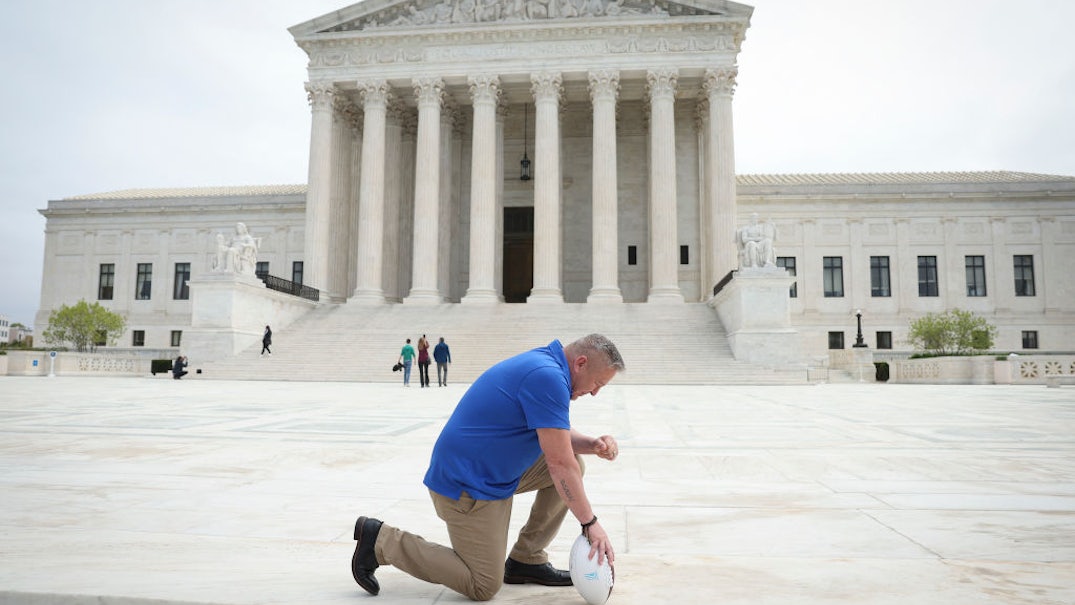First guns and abortion, now school prayer. In a matter of days, the Supreme Court’s conservative majority has handed down sweeping rulings that touch some of the most divisive issues in contemporary America.
On Monday, the Court ruled in Kennedy v. Bremerton School District that a high school football coach had a constitutional right to pray at the 50-yard line following his team’s games. The decision came less than a week after the Court ruled that Maine could not exclude religious schools from a tuition assistance program, effectively deciding that if a state uses taxpayer money to pay tuition to non-religious private schools, it must also do so for religious schools.
Both decisions were significant victories for religious conservatives and further eroded the so-called “separation between church and state” — a phrase that, though it doesn’t appear in the Constitution, governed several decades of Supreme Court First Amendment jurisprudence. Those days seem far off now. “Today,” Justice Sonia Sotomayor wrote in the Maine school voucher case, “the court leads us to a place where separation of church and state becomes a constitutional violation.”
There has always been a tension between the First Amendment’s first two clauses: the one prohibiting the “establishment” of religion and the one protecting its “free exercise.” First Amendment scholars have long expected that this particular Supreme Court, which is stacked with six Republican appointees, would be more concerned with aggressively defending religious freedom than guarding against the state’s sanctioning of religion.
“At its high water mark, the Supreme Court was invalidating programs that would funnel government money to religious uses, especially in the public schools but not only there,” Nelson Tebbe, the Jane M.G. Foster Professor of Law at Cornell Law School, told me last November. “These days,” he added, “the Establishment Clause does very little work as hard constitutional law. At most, it requires the government to be neutral, but it doesn’t seem to require a separation of church and state.”
John Q. Barrett, the Benjamin N. Cardozo Professor of Law at St. John’s University School of Law, said, “Right now the pendulum has swung toward a robust inflated protection for free exercise, and less of a concern about establishment,” adding, “there is a majority of the Court that thinks that the Free Exercise Clause — thinks that religion — has to be treated at least as well as, if not better than, secular activity.”
But if we knew the Court was heading this way, the manner in which it did was somewhat surprising. The Kennedy case, about the football coach, ended like many debates in American life today: it devolved into a dispute over the basic facts.
First, some background. The coach, Joseph Kennedy, was placed on administrative leave at his Seattle-area public high school when, in 2015, he continued to pray at midfield after the school board warned him not to engage in prayer that interfered with his job or involved students. Kennedy’s refusal to stop praying became something of a cause célèbre for the religious Right: during the homecoming game, Kennedy, surrounded by TV cameras, players, and a state legislator, knelt to pray as the crowd stormed the field.
Here’s how Justice Neil Gorsuch, who wrote the majority opinion, described Kennedy’s prayer sessions: “Mr. Kennedy prayed during a period when school employees were free to speak with a friend, call for a reservation at a restaurant, check email, or attend to other personal matters. He offered his prayers quietly while his students were otherwise occupied.”
Justice Sotomayor disagreed with that characterization. In her dissent, she wrote that calling Kennedy’s prayers private “misconstrues the facts.” “The record reveals that Kennedy had a longstanding practice of conducting demonstrative prayers on the 50-yard line of the football field,” she continued. “Kennedy consistently invited others to join his prayers and for years led student athletes in prayer at the same time and location.” Sotomayor also noted the “severe disruption” that the media spectacle caused the school and its students.
Sotomayor also did something unusual: she brought receipts. In her dissent, she included a picture of Kennedy surrounded by dozens of kneeling players, appearing to lead a group prayer instead of participating in a private one. Kennedy is standing in the center with his helmet lifted above his head.
The substantive debate over the case harkened back to the age-old seesaw between the Free Exercise and Establishment clauses of the First Amendment. “We are aware of no historically sound understanding of the Establishment Clause that begins to ‘(make) it necessary for government to be hostile to religion’ in this way,” Gorsuch wrote.
Sotomayor countered that the decision “yet again pay[s] almost exclusive attention to the Free Exercise Clause’s protection for individual religious exercise while giving short shrift to the Establishment Clause’s prohibition on state establishment of religion.”
Sotomayor continued: “It elevates one individual’s interest in personal religious exercise, in the exact time and place of that individual’s choosing, over society’s interest in protecting the separation between church and state, eroding the protections for religious liberty for all.”
Please write to us at letters@cafe.com.




























